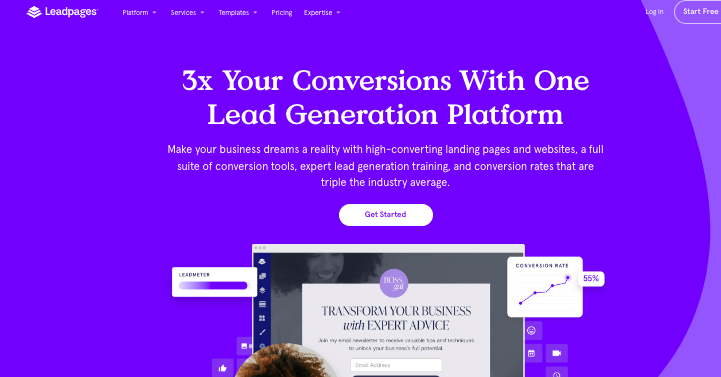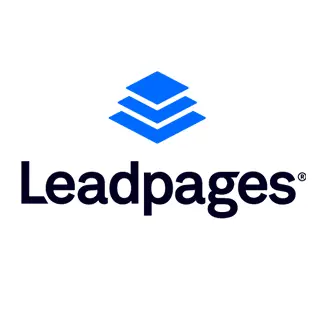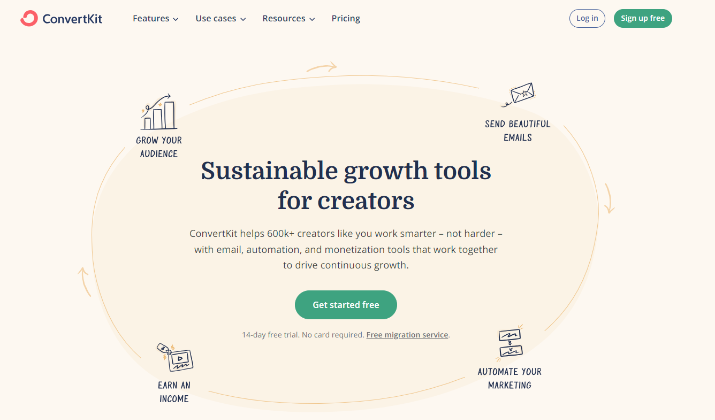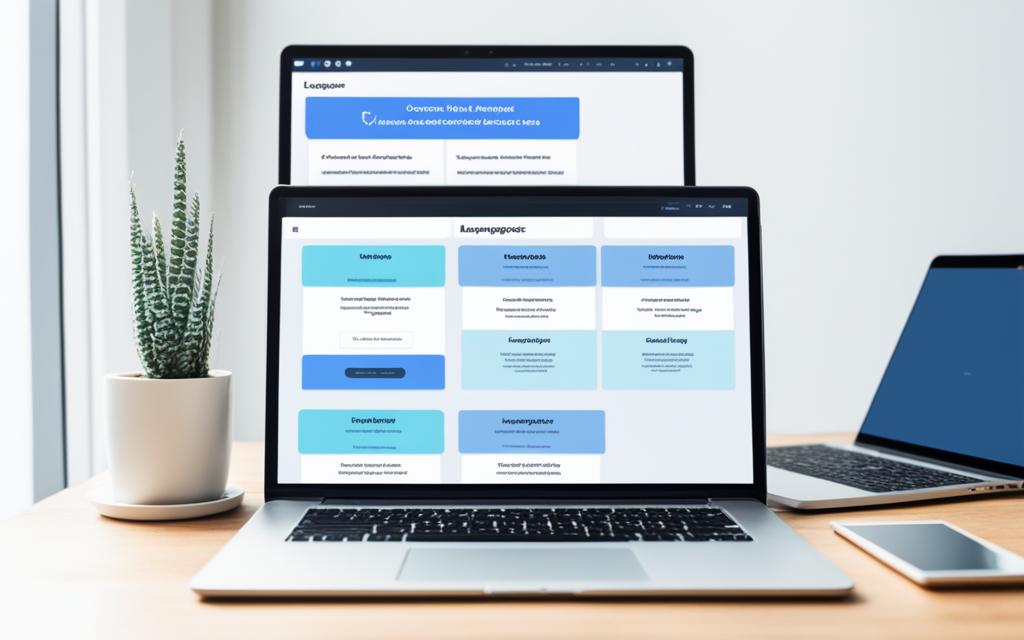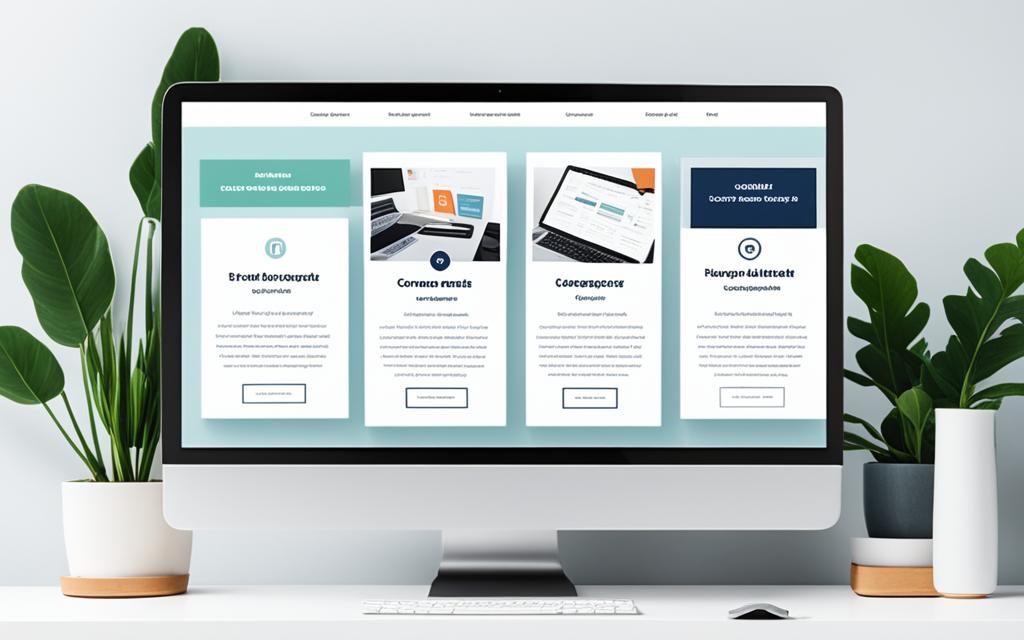Leadpages emerged in 2012 as a leading marketing platform specializing in creating high-converting landing pages.
Its focus on helping businesses optimize conversions allows users to benefit from its extensive library of templates and features designed for effective lead generation.
ConvertKit, another marketing tool, was founded in 2013. It quickly became popular among creative professionals such as artists, bloggers, and YouTubers.
The platform stands out due to its powerful email marketing automation capabilities, enabling users to manage customer relationships effectively.
With features like automated journeys and a flexible tagging system, ConvertKit has gained traction among marketers looking for reliable marketing tools.
Both Leadpages and ConvertKit serve critical functions in the realm of online marketing. As you explore these platforms further, you will understand how they can help you tackle challenges related to lead generation and customer engagement.
With both platforms offering unique strengths, you can leverage their capabilities to meet your specific marketing goals.
Let’s get started.
Also Read: Leadpages vs Wix
Leadpages
Leadpages is an online platform tailored for creating high-converting landing pages. With over 45,000 users, it serves as a robust landing page builder that simplifies the process of lead generation.
Here is what you get with Leadpages:
Landing Page Builder
Leadpages’ drag-and-drop landing page builder makes it easy for anyone to create professional-looking landing pages without any coding knowledge. Users can choose from over 200 mobile-responsive templates, customize them with creative tools, and publish their pages quickly.
Lead Generation and Management
Leadpages provides unlimited landing pages, traffic, and leads, making it easy to scale your lead generation efforts. The platform offers a variety of lead generation tools, including opt-in forms, pop-ups, and alert bars, which can be easily integrated into your landing pages.
Analytics and A/B Testing
Leadpages’ built-in analytics tool provides real-time insights into the performance of your landing pages, pop-ups, and alert bars. Users can also conduct A/B testing to optimize their pages and improve conversion rates.
Get all that your business needs. Engage visitors, gather leads, make customers. Leadpages helps you design beautiful web and landing pages with its simple to use tools. Subscribe to it today!
Integrations
Leadpages integrates with over 40 popular tools, including email marketing platforms, CRMs, and e-commerce solutions. This allows users to seamlessly connect their lead generation efforts with their other marketing and sales activities.
AI-powered Features
Leadpages has recently incorporated AI technology into its platform, offering features like AI copywriting and image generation. Users can generate headlines, paragraphs, and CTAs in seconds, as well as create custom images for their landing pages
Customer Support
Leadpages offers excellent customer support, including live chat, email, and phone support (depending on the plan). The platform also provides free training webinars and a comprehensive knowledge base to help users get the most out of their Leadpages account.
Overall, Leadpages is a robust lead generation platform that offers a wide range of features to help businesses create high-converting landing pages and grow their online presence.
Its user-friendly interface, powerful lead generation tools, and excellent customer support make it a popular choice for entrepreneurs and small businesses.
Check Out: Leadpages vs WordPress
ConvertKit
ConvertKit stands out as a comprehensive platform that specializes in email marketing automation, primarily designed for content creators.
Its suite of features enables you to build automated sales funnels, manage your subscribers efficiently, and create engaging landing pages.
With ConvertKit, you can launch email campaigns while precisely tailoring your email sequences to different segments of your audience.
Here are the key features of ConvertKit:
Audience Growth Tools
- Landing Pages and Forms: ConvertKit offers customizable landing pages and opt-in forms to help users capture email addresses. These tools are easy to set up and do not require coding skills. Users can choose from a variety of templates and embed forms on their websites or use standalone landing pages.
- Creator Profile: This feature acts as a hub for creators, allowing them to showcase their content, products, and newsletters in one place. It helps convert social media followers into email subscribers.
- Creator Network: Users can join a community of creators to cross-promote each other’s work, which can significantly boost subscriber growth through recommendations.
Email Marketing
- Email Designer: ConvertKit provides a point-and-click email designer with pre-made templates, making it easy to create visually appealing emails. Users can also design custom emails from scratch.
- Automations: The visual automation builder allows users to create complex workflows based on subscriber actions, such as opening emails or making purchases. This feature supports detailed customer journeys with multiple entry and exit points.
- Broadcasts and Sequences: Users can send one-off broadcasts or create automated email sequences (autoresponders) to nurture leads over time.
Monetization Options
- Selling Digital Products: ConvertKit enables users to sell digital products directly through the platform or integrate with third-party e-commerce tools like Shopify and WooCommerce. It supports various pricing models, including one-time payments, subscriptions, and donations.
- Tip Jar: This feature allows creators to receive tips from their audience, providing a low-barrier way to monetize their work.
Also Read: ThriveCart vs ConvertKit
Integrations and Support
- Integrations: ConvertKit integrates with numerous platforms, including website builders, course platforms, and CRMs, allowing users to connect their email marketing with other business tools.
- Customer Support: The platform offers free migration assistance for new users switching from other email services, alongside personalized support options and a knowledge base for troubleshooting.
Leadpages vs ConvertKit – What’s the Main Difference?
When comparing Leadpages and ConvertKit, you will notice significant features difference in their offerings.
Leadpages stands out for its ability to create captivating landing pages equipped with various tools for optimization and lead generation.
The platform excels in producing visually appealing pages without demanding extensive technical skills, making it ideal for creating high-converting landing pages for marketing campaigns.
On the other side, ConvertKit serves as a powerhouse for email marketing automation. It allows users to design automated sequences and streamline communication with their audience.
Get all that your business needs. Engage visitors, gather leads, make customers. Leadpages helps you design beautiful web and landing pages with its simple to use tools. Subscribe to it today!
The platform shines in areas such as detailed audience segmentation, making it effective for personalized marketing strategies.
User experiences highlight ConvertKit’s intuitive visual automation builder, which simplifies crafting workflows based on subscriber behavior.
Use cases for both platforms can differ based on your marketing objectives.
If your goal is to enhance lead generation through landing pages, Leadpages is your go-to choice. For those focused on nurturing leads via email campaigns, ConvertKit often emerges as the preferred solution.
Also Read: SamCart vs ConvertKit
How Good is Leadpages as a Landing Page Builder?
Leadpages is a solid landing page builder offering great set of features for building high-converting landing pages.
Here are some of its strengths and also areas where it can improve.
Strengths
- Ease of Use: Leadpages is praised for its user-friendly interface, making it accessible for beginners. The drag-and-drop editor allows users to create landing pages quickly without needing coding skills.
- Affordability: With pricing starting at $37 per month when billed annually, Leadpages is considered a cost-effective option compared to competitors like Unbounce and Instapage, which can be significantly more expensive.
- Conversion-Focused Templates: The platform offers a wide range of templates optimized for conversions, which can help users generate leads more effectively. These templates are based on extensive data and can be filtered by conversion rates.
- Comprehensive Features: Beyond landing pages, Leadpages includes tools for pop-ups, alert bars, and even a website builder. It also supports A/B testing and integrates well with various third-party applications, enhancing its functionality as a marketing tool.
- No Traffic Limitations: Unlike some competitors, Leadpages does not impose traffic limits on its plans, making it suitable for businesses expecting to grow their audience significantly.
Get all that your business needs. Engage visitors, gather leads, make customers. Leadpages helps you design beautiful web and landing pages with its simple to use tools. Subscribe to it today!
Weaknesses
- Limited Customization: While Leadpages provides a variety of templates, users often find the customization options somewhat restrictive. This can be a drawback for those seeking more control over their page designs.
- Performance Issues: Some reviews note that the drag-and-drop editor can be sluggish, which may hinder the user experience when building pages.
- Basic A/B Testing: The Standard plan offers limited A/B testing capabilities, which might not meet the needs of users who require extensive testing options.
- Not a Full-Stack Solution: While Leadpages is effective for creating landing pages, it is not a comprehensive all-in-one platform for managing an entire online business. Users may need to integrate it with other tools for complete functionality.
Leadpages is a solid choice for small businesses and solopreneurs looking for an affordable and easy-to-use landing page builder.
While it may not offer the same level of customization and advanced features as some higher-end competitors, its strengths in usability and cost-effectiveness make it a popular option in the market.
How Good is ConvertKit as an Email Marketing Tool?
ConvertKit’s email marketing side is highly regarded by creators, bloggers, podcasters, and online entrepreneurs. It is easily among the top five email marketing tools available in the market today.
Here’s an analysis of its strengths and weaknesses:
Strengths
- User-Friendly Interface: ConvertKit is noted for its clean and intuitive design, making it easy for users to navigate and utilize its features effectively, even for those new to email marketing.
- Automation Features: The platform excels in automation capabilities, offering a visual workflow builder and numerous pre-built automation templates. This allows users to create complex email sequences based on subscriber actions, significantly enhancing marketing efficiency.
- Segmentation and Tagging: ConvertKit provides robust list management tools, including smart tagging and segmentation. This enables users to send highly targeted messages to specific audience segments, improving engagement and conversion rates.
- Landing Pages and Forms: Users can easily create landing pages and opt-in forms without extensive design skills. ConvertKit includes a selection of attractive templates to facilitate lead capture.
- E-Commerce Integration: The platform allows users to sell digital products directly from their emails or landing pages, streamlining the process of monetizing content without needing third-party tools.
Weaknesses
- Limited Customization: While ConvertKit offers essential features, some users find the email design options to be somewhat basic. The platform intentionally limits customization to maintain simplicity, which may not satisfy those looking for extensive design flexibility.
- Analytics and Reporting: Although ConvertKit provides basic analytics, some users feel that its reporting capabilities are not as comprehensive as those offered by other email marketing platforms. This can make it challenging to optimize campaigns effectively.
- Cost Considerations: While ConvertKit offers a free tier, its pricing can become steep as your subscriber list grows, which may be a concern for some users.
Also Read: Brevo vs Systeme
Can I Use Both Leadpages and Convertkit Together? Is it Beneficial?
Yes, you can use both Leadpages and ConvertKit together, and there are several benefits to doing so.
Streamlined Lead Capture
By integrating Leadpages with ConvertKit, you can easily send leads captured through your landing pages directly to your ConvertKit forms.
This simplifies the process of managing your email list and ensures that all subscriber data is centralized in one place.
Enhanced Automation
ConvertKit excels in automation, allowing you to create personalized email sequences based on user interactions.
When you use Leadpages to capture leads, you can trigger these automated email sequences, enhancing your marketing efforts and improving engagement with your audience.
Optimized Landing Pages
Leadpages provides a variety of high-converting templates and a user-friendly drag-and-drop builder.
When combined with ConvertKit’s email marketing capabilities, you can create effective landing pages that not only attract visitors but also convert them into subscribers, which can then be nurtured through targeted email campaigns.
Segmentation and Targeting
With ConvertKit’s tagging and segmentation features, you can categorize your leads based on their behavior and interests.
This allows for more targeted email marketing efforts, which can be set up seamlessly when leads are captured through Leadpages.
Get all that your business needs. Engage visitors, gather leads, make customers. Leadpages helps you design beautiful web and landing pages with its simple to use tools. Subscribe to it today!
Comprehensive Marketing Strategy
Using both tools allows you to build a cohesive marketing strategy where landing pages, lead capture, and email marketing work together efficiently.
The integration can lead to improved conversion rates and a better return on investment for your marketing efforts.
In summary, leveraging both Leadpages and ConvertKit can significantly enhance your marketing capabilities by streamlining lead capture, improving automation, and optimizing your overall strategy.
Conclusion
By now, you would know that both platforms excel in different areas of digital marketing.
Leadpages stands out as a top choice for businesses aiming to enhance lead generation through its comprehensive landing page capabilities.
In contrast, ConvertKit offers powerful email marketing automation tools that cater specifically to content creators and marketers.
Its capabilities in audience segmentation and auto-responder sequences are superior compared to many other platforms.
Ultimately, your decision between Leadpages and ConvertKit should align with your individual marketing objectives.
If you want to optimize your landing pages as well as want to reach out to potential leads and customers, using both Leadpages and Convertkit is the best idea.

